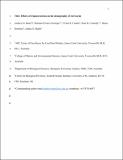Files in this item
Effects of tropical storms on the demography of reef corals
Item metadata
| dc.contributor.author | Baird, Andrew H. | |
| dc.contributor.author | Alvarez-Noriega, Mariana | |
| dc.contributor.author | Cumbo, Vivian R. | |
| dc.contributor.author | Connolly, Sean R. | |
| dc.contributor.author | Dornelas, Maria | |
| dc.contributor.author | Madin, Joshua S. | |
| dc.date.accessioned | 2019-11-15T00:36:47Z | |
| dc.date.available | 2019-11-15T00:36:47Z | |
| dc.date.issued | 2018-11-15 | |
| dc.identifier | 257352167 | |
| dc.identifier | 2d5ec481-2e5f-4b63-a191-345033b20df8 | |
| dc.identifier | 000450352900003 | |
| dc.identifier | 85056836189 | |
| dc.identifier | 000450352900003 | |
| dc.identifier.citation | Baird , A H , Alvarez-Noriega , M , Cumbo , V R , Connolly , S R , Dornelas , M & Madin , J S 2018 , ' Effects of tropical storms on the demography of reef corals ' , Marine Ecology Progress Series , vol. 606 , pp. 29-38 . https://doi.org/10.3354/meps12760 | en |
| dc.identifier.issn | 0171-8630 | |
| dc.identifier.uri | https://hdl.handle.net/10023/18931 | |
| dc.description | Funding was provided by the Australian Research Council Centre of Excellence for Coral Reef Studies (CE140100020), a Future Fellowship (A.H.B.), an Australian Professorial Fellowship (S.R.C.) and the Templeton Foundation (grant no. 60501, ‘Putting the Extended Evolutionary Synthesis to the Test’). M.D. is grateful to the Scottish Funding Council (MASTS, grant reference HR09011) and the European Research Council (grant BioTIME). | en |
| dc.description.abstract | Disturbances, such as cyclones, have a major effect on the structure and dynamics of coral reef assemblages. However, the effect of cyclones on demographic traits, such as fecundity, has rarely been quantified, and direct estimates of mortality at the species level are rare. Here, we document the effect of Severe Tropical Cyclone Nathan on the demography of corals on the reef crest at Trimodal Reef in the northern Great Barrier Reef. Mortality rates based on tagged colonies were very high, ranging from 85.2% in Goniastrea retiformis to 100% in 6 Acropora species, 3 to 40 times higher than averages rates in the 5 yr preceding Cyclone Nathan. Fecundity was lower in 3 out of the 4 species examined following the cyclone, and egg carbon content was reduced by 58-63% in the 2 species examined. These results suggest that energy normally invested in reproduction was diverted to other processes such as injury repair and demonstrate that cyclones have important sub-lethal effects in addition to high rates of whole colony mortality. Coral cover was reduced from 34.9 ± 3.9% (mean ± SE) to 3.4 ± 1.5%, with reductions in the cover of all taxa except those with predominantly massive morphologies such as the Poritidae. A projected increase in the frequency of tropical storms as a result of global warming, combined with an increase in the frequency and scale of coral bleaching, suggest a fundamental shift in mortality regimes on reefs which has the potential to threaten their long-term persistence. | |
| dc.format.extent | 10 | |
| dc.format.extent | 1244554 | |
| dc.language.iso | eng | |
| dc.relation.ispartof | Marine Ecology Progress Series | en |
| dc.subject | Coral reefs | en |
| dc.subject | Climate change | en |
| dc.subject | Demography | en |
| dc.subject | Disturbance | en |
| dc.subject | Recovery | en |
| dc.subject | QH301 Biology | en |
| dc.subject | NDAS | en |
| dc.subject | SDG 13 - Climate Action | en |
| dc.subject.lcc | QH301 | en |
| dc.title | Effects of tropical storms on the demography of reef corals | en |
| dc.type | Journal article | en |
| dc.contributor.sponsor | European Research Council | en |
| dc.contributor.institution | University of St Andrews. School of Biology | en |
| dc.contributor.institution | University of St Andrews. Centre for Biological Diversity | en |
| dc.contributor.institution | University of St Andrews. Fish Behaviour and Biodiversity Research Group | en |
| dc.contributor.institution | University of St Andrews. Marine Alliance for Science & Technology Scotland | en |
| dc.identifier.doi | 10.3354/meps12760 | |
| dc.description.status | Peer reviewed | en |
| dc.date.embargoedUntil | 2019-11-15 | |
| dc.identifier.grantnumber | 250189 | en |
This item appears in the following Collection(s)
Items in the St Andrews Research Repository are protected by copyright, with all rights reserved, unless otherwise indicated.

